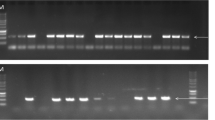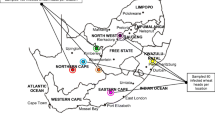Abstract
Species associated with Fusarium head blight are depending on the production and edaphic conditions. The differences are found in the representation of various Fusarium spp. in the diseases, which sporadically occur all over the territory of Slovakia, in all agricultural production types. We identified fifteen Fusarium species during ten years of investigation. Most of the mentioned species F. culmorum (W.G. Smith) Sacc., F. graminearum Schwabe, recently F. cerealis (Cooke) Sacc. (crookwellense Burgess, Nelson & Tousson) and F. sambucinum Fuckel in diseased caryopsis are seed transmitted. The significant differences among species and intra species in cultural and pathogenicity assays in vitro and in vivo were correlated. Some of them are able to produce toxic metabolites — deoxynivalenone, which probably play a role in the aggressiveness of the pathogen and promote disease development and pathogen colonization.
Similar content being viewed by others
References
Bai H.H., Desjardins A.E. & Platner R.D. 2001. Deoxynivalenol — nonproducing F. graminearum causes initial infection, but does not cause disease spread in wheat spike. Mycopathol. 153: 91–98.
Booth C. 1977. The genus Fusarium. Kew, Surrey, Commonwealth Mycological Institute, 237 pp.
Bottalico A. & Perrero G. 2002. Toxigenic Fusarium species and mycotoxins associated with head blight in small grain cereals in Europe. Eur. J. Plant Pathol. 108: 611–624.
Clear R.M. & Patrick S.K. 2000. Fusarium head blight pathogens isolated from Fusarium-damaged kernels of wheat in western Canada, from 1993 to 1998. Can. J. Plant Pathol. 22: 51–60.
Desjardin A.E. & Hohn T.M. 1997: Mycotoxins in plant pathogenesis. Mol. Plant Microbe Interact. 10: 147–152.
Dusabenyag A., Asani B., Dostaler D. & Hamelin R.C. 1999. Genetic diversity among Fusarium graminearum strains from Ontario and Quebec. Can. J. Plant. Pathol. 21: 308–314.
Gargoliu S., Bernier L., Hajlaoui M.R. & Marrakchim I. 2003. Genetic variability and population structure of the wheat foot rot fungus, Fusarium culmorum, in Tunisia. Europ. J. Plant Pathol. 109: 807–815.
Gilbert J., Fernando W.G.D., Ahmed H.U. & Brûlé-Babel A. 2004. The role of crop stubble in production of inoculums of Fusarium graminearum, pp. 142–147. In: Canty S.M., Boring T., Wardwell J. & Ward R.W. (eds), Proceedings of 2nd International symposium on Fusarium head blight incorporating the 8th European Fusarium seminar, December 11–15, 2004. Orlando, Florida, USA.
Hestbjergh H., Felding G. & Elmhot S. 2002. Fusarium culmorum infection of barley seedlings: Correlation between aggressiveness and deoxynivalenol content. J. Phytopathol. 6: 308–312.
Chelkowski J. 1989. Formation of mycotoxins produced by Fusaria in heads of wheat, triticale and rye, pp. 63–84. In: Chełkowski J. (ed.), Fusarium Mycotoxins, Taxonomy and Pathogenicity. Elsevier, Amsterdam, Oxford, New York, Tokyo.
Logrieco A., Mulè G., Moretti A. & Bottalico A. 2002. Toxigenic Fusarium species and mycotoxins associated with maize ear rot in Europe. Europ. J. Plant Pathol. 108: 579–609.
Mirocha C.J., Wasowicz E. & Kaminski E. 1995. Production of volatile sesquiterpenes by Fusarium sambucinum strains with different abilities to synthesize trichothecenes. Appl. Environ. Microbiol. 11: 3815–3820.
Miedaner T. & Schilling A.G. 1996. Genetic variation of aggressiveness in individual field populations of Fusarium graminearum and Fusarium culmorum tested on young plants of winter with Fusarium foot rot of winter wheat in the semiarid Pacific Northwest. Plant Dis. 80: 944–949.
Miedaner T., Reinbrecht C. & Schilling A.G. 2000. Association among aggressiveness, fungal colonization, and mycotoxin production of 26 isolates of Fusarium graminearum in winter rye head blight. Z. Pflanzen Krankh. Pflanzen Schutz. 107: 124–134.
Miedaner T., Schilling A.G. & Geiger H.H. 2001. Molecular genetic diversity and variation for aggressiveness in populations of Fusarium graminearum and Fusarium culmorum sampled from wheat fields in different countries. J. Phytopathol. 149: 641–648.
Mirocha C.J., Hui Y., Evans C.K., Kolaczowski R. & Macky D. 1997. Chemistry and physiology of deoxynivalenol in pathogenesis. Cereal Res. Comm. 25: 309–313.
Nelson P., Tousson T.A. & Marasas W.F. 1983. Fusarium species. An illustrated manual for identification. The Pennsylvania State Univ. Press, Pennsylvania, 172 pp.
Parry D.W., Jenkinson P. & McLeod L. 1995. Fusarium ear (scab) in small grain cereals — a review. Plant Pathol. 44: 207–238.
Perkowski J., Stachowiak J., Kiecana I., Golinski P. & Chełkowski J. 1997. Natural occurrence of Fusarium mycotoxins in Polish cereals. Cereal Res. Comm. 25: 379–380.
Perkowski J., Pavlová A., Šrobárová A., Stachowiak J. & Golinski P. 2002. Group B trichothecenes biosynthesis in wheat cultivars after heads inoculation with Fusarium culmorum isolates. Biologia, Bratislava, 57(6): 765–771.
Schilling A.G., Miedaner T. & Geiger H.H. 1997. Molecular variation and genetic structure in field populations of Fusarium species causing head blight in wheat. Cereal Res. Comm. 25: 549–554.
Snijders Ch.A. & Perkowski J. 1990. Effects of head blight caused by Fusarium culmorum on toxin content and weight of wheat kernels. Phytopathol. 80: 566–570.
Šrobárová A. 2001. Fusarium spp. on cereals in Slovakia, pp. 159–165. In: Logrieco A. (ed.), Occurrence of toxigenic fungi and mycotoxins in plants, food and feed in Europe. COST Action 835, Office for official publications of the European Communities, Luxembourg.
Šrobárová A. & Pavlová A. 2002. The resistance of wheat to Fusarium culmorum and its metabolites — a survey. J. Appl. Genet. 43A: 193–196.
Toth A. 1997. Dominance condition on Fusarium species occurring in winter wheat kernels in pest country. Cereal Res. Comm. 25: 625–627.
Vančo B., Šudiová S. & Šliková V. 2007. Influence of localities and winter wheat cultivars on deoxynivalenol accumulation and disease damage by Fusarium culmorum. Biologia 62: 62–66.
Wildermuth G.B. & McNamara R.B. 1994. Testing wheat seedling for resistance to crown rot caused by Fusarium graminearum group 1. Plant Dis. 78: 949–953.
Wisniewska H. & Busko M. 2005. Evaluation of spring wheat resistance to Fusarium seedling blight and head blight. Biologia 60: 287–293.
Author information
Authors and Affiliations
Corresponding author
Rights and permissions
About this article
Cite this article
Šrobárová, A., Šliková, S. & Šudyova, V. Diversity of the Fusarium species associated with head and seedling blight on wheat in Slovakia. Biologia 63, 332–337 (2008). https://doi.org/10.2478/s11756-008-0050-y
Received:
Accepted:
Published:
Issue Date:
DOI: https://doi.org/10.2478/s11756-008-0050-y




